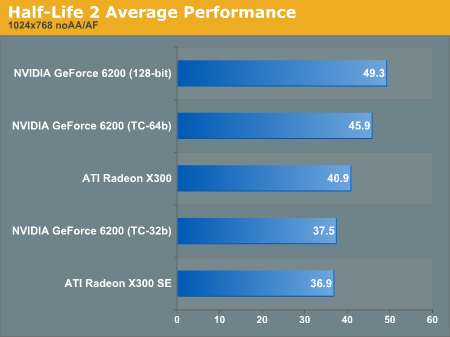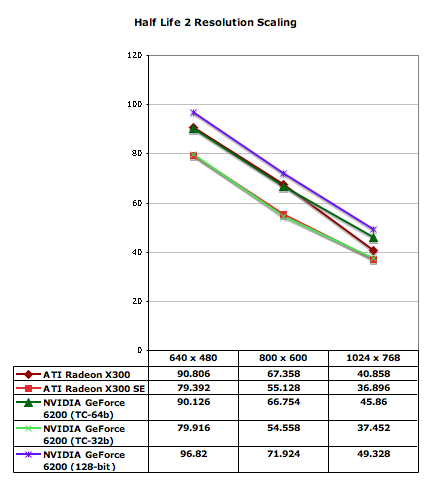GeForce 6200 TurboCache: PCI Express Made Useful
by Derek Wilson on December 15, 2004 9:00 AM EST- Posted in
- GPUs
Half-Life 2 Performance
Here is the raw data we collected from our Half-Life 2 performance analysis. The data shows fairly consistent performance across all the levels we test.| Half-Life 2 1024x768 Performance | |||||
| at_canals_08 | at_coast_05 | at_coast_12 | at_prison_05 | at_c17_12 | |
| GeForce 6200 (128-bit) | 43.6 | 65.23 | 50.4 | 41.57 | 45.84 |
| GeForce 6200 (TC-64b) | 38.26 | 61.81 | 48.2 | 38.92 | 42.11 |
| Radeon X300 | 34.3 | 57.54 | 39.14 | 32.62 | 40.69 |
| GeForce 6200 (TC-32b) | 31.66 | 51.09 | 39.72 | 30.69 | 34.1 |
| Radeon X300 SE | 29.59 | 52.42 | 34.91 | 30.55 | 37.01 |
The X300 SE and new 32-bit TurboCache cards are very evenly matched here. The original 6200 leads every time, but the TC versions do hold their own fairly well. The regular X300 isn't quite able to keep up with the 64-bit version of the 6200 TurboCache, especially in particularly GPU limited levels. This comes across in a higher average performance at high resolutions.
Again, Unlike Doom 3, the TurboCache parts are able to keep up with the 128-bit 6200 part fairly well. This has to do with the ammount of memory bandwidth required to process each pixel, and HL2 is more evenly balanced between being GPU dependant and memory bandwidth dependant.


We can see from the resolution scaling chart that in cases other than 1024x764, the competition between the X300 series and the 6200 TurboCache parts is a wash. It is impressive that all these cards run HL2 at very playable framerates in all our tests.










43 Comments
View All Comments
PrinceGaz - Thursday, December 16, 2004 - link
#28- see page 2 of the article, the text just above the diagram near the bottom of the page "Even on the 915 chipset from Intel, bandwith is limited across the PCI Express bus. Rather than a full 4GB/s up and 4GB/s down, Intel offers only 3GB/s up and 1GB/s down..."#25- I'd also always assumed that all PCIe x16 sockets could support 4GB/s both ways, this is the first time I've heard otherwise. And it isn't even 4/1, it's 3/1 according to the info given.
Derek- is this limited PCIe x16 bandwidth common to all chipsets?
DerekWilson - Thursday, December 16, 2004 - link
We tested the 32MB 64-bit $99 version of the card that "supports" a 128MB framebuffer.#31 is correct -- the maximum of 112 of 96 (or 192 for the 256 MB version) of system RAM is not staticly mapped. It's always avalable to the system under 2D operation. Under 3D, it's not likely that the entire framebuffer would be absolutely full at any given time anyway.
Alphafox78 - Thursday, December 16, 2004 - link
doesnt it dynamicly allocate the extra memory it needs? so this would just affect games then if it needed more, not regular apps that done need lots of video memory.rqle - Thursday, December 16, 2004 - link
so total cost of these card is the card price + (price of 128MB worth of DDR at the time)?Maverick2002 - Thursday, December 16, 2004 - link
I'm likewise confused. At the end of the review they say:"There will also be a 64MB 64-bit TC part (supporting 256MB) available for $129 coming down the pipeline at some point, though we don't have that part in our labs just yet."
Didn't they just test this card???
KalTorak - Thursday, December 16, 2004 - link
#25 - huh? (I have no idea what that term means in the context of PCIe, and I know PCIe pretty well...)KayKay - Thursday, December 16, 2004 - link
I think this is a good product, i think it could be a very good part for companies like dell, if they include it into their systems. cheaper than the x300se's they currently include, but better performance, and will appeal to that type of customermczak - Wednesday, December 15, 2004 - link
#24, from the description it sounds like for the radeon igp there is no problem with both using sideport and system memory simultaneously for directly rendering into (the interleaved mode exactly sounds like part of all buffers would be allocated in system memory, though maybe that's not what is meant).IntelUser2000 - Wednesday, December 15, 2004 - link
WTF!! I never new Intel's 915 chipsets used 4/1GB implementation of PCI Express!! Even Anandtech's own article didn't say that they said 4/4.DerekWilson - Wednesday, December 15, 2004 - link
As far as I understand Hypermemory, it is not capable of rendering directly to system memory.Also, when Hypermemory needs to go to allocate system RAM for anything, there is a very noticeable performance hit.
We tested the 16MB/32-bit and the 32MB/64-bit
The 64MB version available is only 64-bit ... NVIDIA uses four 8M x 16 memory chips.